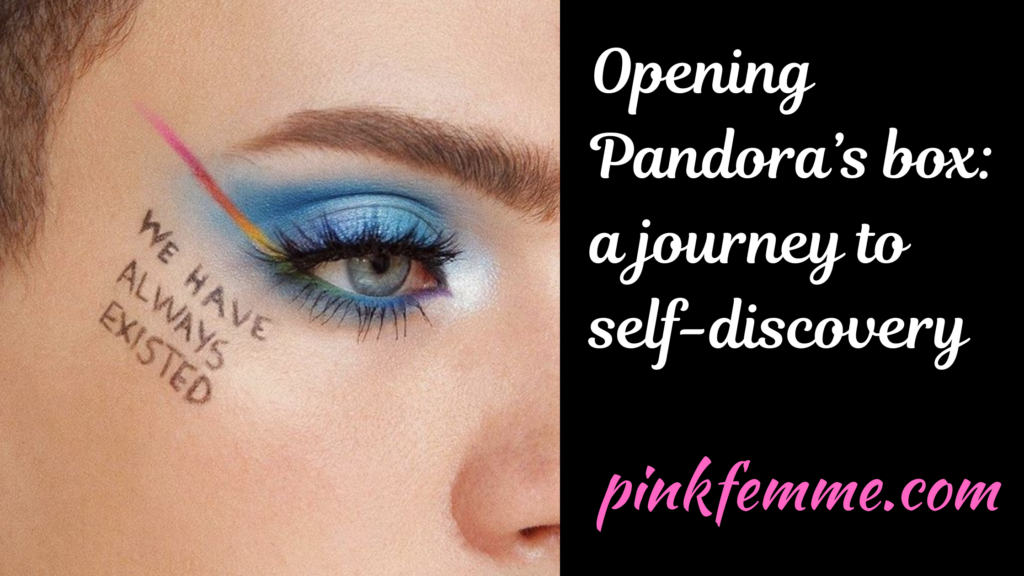
When it comes to understanding ourselves, few experiences are as profound and life-altering as the realization of gender dysphoria. It’s often described as a Pandora’s box, unlocking hidden truths and stirring emotions that feel overwhelming and disorienting. Many of us find ourselves suddenly face-to-face with aspects of our identity that we’ve long buried or ignored. In this article, I’ll guide you through what happens when Pandora’s box opens, why it can feel so terrifying, and how to navigate the journey ahead.
When the Pandora’s box of dysphoria is opened, it reveals deep truths about your gender identity, often triggering anxiety and self-discovery. While it can’t be fully “closed” again, understanding and embracing these truths can lead to a more authentic and fulfilling life.
If you’ve opened Pandora’s box, you may feel overwhelmed, uncertain, or even desperate to “put everything back.” These feelings are normal and valid. I’m here to assure you that while this process is challenging, it’s also an opportunity to grow into a more authentic version of yourself. Let’s explore this journey together.
What Does It Mean to Open Pandora’s Box of Dysphoria?
A Defining Moment of Realization
For many, dysphoria surfaces at different stages of life. It can emerge in childhood, adolescence, or well into adulthood. For some, it might happen even later—in their 40s, 50s, or beyond. Each experience is unique, but the common thread is a sense of deep self-awareness that cannot be ignored.
Triggers for Opening the Box
Sometimes, this awakening is sparked by an external event, such as:
- Watching a film or reading a story with gender-diverse characters.
- Engaging in role-reversal play or trying on clothing traditionally associated with another gender.
- Conversations or moments that challenge societal norms about gender.
These triggers can feel minor to outsiders but are often profound for the individual, acting as a catalyst for self-reflection.
The Inescapable Truth
When the box is opened, it’s not merely about discovering dysphoria—it’s about confronting aspects of your identity that may have been buried or denied. The emotions that follow are complex and deeply personal, ranging from fear and confusion to relief and clarity.
The Immediate Aftermath: Freakouts and Anxiety
The Emotional Rollercoaster
Opening Pandora’s box can trigger an emotional rollercoaster, with highs and lows that seem to come out of nowhere. Common emotions include:
- Shock and Disbelief: Feeling blindsided by the intensity of your emotions.
- Fear and Anxiety: Worrying about the implications for your life, relationships, and future.
- Elation and Relief: Experiencing a sense of freedom or clarity after years of confusion.
These emotions can overlap or occur in rapid succession, leaving you feeling unmoored and uncertain about what to do next.
Coping with Fear and Overwhelm
It’s natural to feel overwhelmed when the ground shifts beneath you. Some immediate concerns might include:
- How Will This Affect My Relationships? The fear of rejection or misunderstanding from loved ones.
- What Does This Mean for My Future? Concerns about career, community acceptance, or long-term goals.
- Am I Ready for This? Doubts about your ability to face such a profound change.
Common Responses to Dysphoria
Most people respond in one of three ways:
- Denial: Attempting to stuff the truth back into the box, convincing yourself that this isn’t real or that it’s a fleeting thought.
- Seeking Professional Guidance: Reaching out to therapists or experts in gender identity, hoping for clarity or reassurance.
- Diving into the Internet: Scouring online resources for answers, often encountering both helpful and harmful information.
Each reaction is a coping mechanism, and none of them are inherently wrong. However, they do highlight the importance of approaching your newfound awareness with care and self-compassion.
The Importance of Grounding Techniques
During this initial period, grounding techniques can help you regain a sense of stability. Try practices such as:
- Deep Breathing: Inhale deeply for a count of four, hold for four, and exhale for four.
- Journaling: Write down your thoughts and emotions to process them more clearly.
- Mindful Movement: Engage in activities like yoga or walking to reconnect with your body.
Building a Support Network
Feeling isolated only heightens anxiety. Reach out to trusted friends, family members, or online communities who can offer encouragement and understanding. Finding a therapist with experience in gender identity issues can also provide a safe space to explore your feelings.
Can Pandora’s Box Be Closed?
The Myth of Reclosure
Once the Pandora’s box of dysphoria is opened, it’s natural to wonder if it can be closed again. The short answer is no. Awareness, once gained, cannot be undone. Denial might suppress the truth temporarily, but dysphoric feelings often resurface stronger and harder to ignore. This doesn’t mean you’re doomed; rather, it signifies a turning point for self-discovery.
The Cost of Denial
Many who attempt to “close the box” find that denial only delays the inevitable. Suppressing your feelings can lead to:
- Heightened anxiety or depression.
- Feelings of alienation or disconnection from yourself.
- Struggles with physical and emotional health as the internal conflict persists.
Why This Is a Gift in Disguise
Pandora’s box is often seen as a curse, but it’s better understood as an opportunity. Opening it reveals hidden truths about yourself that demand acknowledgment. While it can feel overwhelming, this awareness allows you to grow into a more authentic and fulfilling version of yourself.
Moving Forward: Embracing the Journey
Understanding the Path Ahead
Opening Pandora’s box is just the beginning. The journey forward involves navigating the complexities of self-discovery, managing fears, and finding empowerment in authenticity. It’s a process that evolves over time, often with unexpected twists and turns.
Creating a Safe Environment for Exploration
Building Your Emotional Toolkit
Before taking significant steps, it’s crucial to create a space where you feel emotionally safe. Some strategies include:
- Mindfulness Practices: Meditation or mindfulness apps can help you remain present in moments of fear or doubt.
- Affirmation Exercises: Start each day with positive affirmations about your worth and courage.
- Boundary Setting: Protect your mental space by limiting exposure to unkind or invalidating people.
Finding Allies
Support systems are vital. Reach out to those who understand and affirm your journey, including:
- Trusted friends or family members.
- Local LGBTQ+ groups or meetups.
- Online communities such as forums, Discord groups, or social media spaces dedicated to gender exploration.
Exploring Identity Through Small Steps

Experimenting Safely
Small, low-risk actions can help you explore your gender identity without overwhelming change. Ideas include:
- Clothing Choices: Experiment with gender-affirming outfits at home or in safe settings.
- Names and Pronouns: Try using different names or pronouns with trusted friends or in online spaces.
- Voice and Mannerisms: Practice changes to voice pitch or gestures that feel more natural to you.
Journaling Your Journey
Documenting your thoughts and experiences is a powerful way to track progress and process emotions. Prompts to consider:
- What do I feel when I express my gender authentically?
- What fears or barriers are holding me back?
- Who am I when I feel most free and true to myself?
Creative Outlets
Art, music, or writing can provide a therapeutic way to explore and express your identity. Whether painting, crafting, or writing poetry, these outlets allow for a safe and private exploration of your feelings.
Seeking Professional Guidance
Finding the Right Therapist
A gender-affirming therapist can be an invaluable resource. They provide:
- A non-judgmental space to explore your feelings.
- Tools to manage anxiety and self-doubt.
- Support in navigating social or medical transitions, if desired.
Understanding Medical Options
If medical transition is part of your journey, researching options like hormone therapy or surgeries can help demystify the process. Work with professionals who respect your pace and decisions.
Embracing Setbacks and Growth
Dealing with Doubts
Doubt is a natural part of the process. Remember, exploration isn’t about instant certainty—it’s about learning what feels right. Give yourself permission to change your mind or revise your understanding of yourself.
Managing External Pressures
The opinions of others may create additional challenges. Strategies to navigate external pressures include:
- Selective Sharing: Share your journey only with those who have earned your trust.
- Practicing Responses: Prepare simple answers for questions or comments, such as, “This is personal, but I’m taking time to figure things out.”
- Reframing Criticism: Remember, others’ discomfort often reflects their limitations, not your worth.
Building Confidence in Your Identity
Celebrating Small Victories
Acknowledge and celebrate progress, no matter how small. Whether it’s using a new name or attending a support group, each step is a testament to your courage.
Visualizing the Future
Think about the life you want to build. Visualization exercises can help clarify goals and reinforce your commitment to authenticity:
- What does a typical day in my ideal life look like?
- How do I want to feel about myself in the future?
- What affirmations or changes would bring me closer to that vision?
Accepting the Ongoing Nature of the Journey
Allowing Flexibility
Gender identity isn’t always a linear process. Some days will feel clear and empowering; others may feel uncertain or frustrating. Accepting this ebb and flow can ease pressure and self-judgment.
Celebrating Authenticity
Ultimately, the journey isn’t about “arriving” at a destination but living authentically along the way. Trust that each step brings you closer to understanding and embracing who you truly are.
The Risks and Rewards of Authenticity
Embracing Your Truth
Living authentically is one of the most courageous things a person can do. For those navigating gender identity, embracing your truth means shedding layers of societal expectations, internalized fears, and the discomfort of living out of alignment with your true self. But with this courage comes a mix of challenges and profound rewards.
The Risks of Living Authentically
Social Pushback
Choosing to live authentically can provoke reactions from others that range from confusion to outright rejection. Challenges include:
- Family Reactions: Some loved ones may struggle to understand or accept your journey. While their reactions often stem from their own fears or biases, the impact on you can be deeply personal.
- Friendship Strains: Long-standing friendships may face tension as people adjust to your evolving identity.
- Workplace Challenges: While many workplaces are becoming more inclusive, there is still a risk of bias or discrimination.
Emotional Vulnerability
Authenticity requires honesty, which can leave you feeling exposed. Risks include:
- Fear of Judgment: Worrying about how others perceive you can be emotionally taxing.
- Doubt: Encountering negativity might make you question your path, especially in the early stages.
- Isolation: Feeling misunderstood or losing connections with unsupportive individuals can lead to moments of loneliness.
Institutional and Societal Obstacles
Depending on your location, navigating societal or institutional challenges can add complexity. These might include:
- Discriminatory Laws or Policies: Lack of protections in areas such as healthcare, housing, or employment.
- Access Barriers: Difficulty finding gender-affirming care or resources, particularly in underrepresented regions.
Coping with Risks
Building Resilience
Facing these risks requires cultivating inner strength and tools for coping:
- Self-Affirmation Practices: Remind yourself daily of your worth and progress.
- Community Support: Surround yourself with people who understand and affirm your journey.
- Therapeutic Guidance: A therapist can help you process rejection, navigate doubts, and build emotional resilience.
Advocacy and Allyship
Fighting for your truth can inspire broader change. Connecting with advocacy groups or allies can make your journey part of a larger movement for inclusivity and equality.
The Rewards of Living Authentically
Inner Peace
The most profound reward of authenticity is the alignment between your internal self and external life. Benefits include:
- Reduced Dysphoria: Authentic expression can alleviate the discomfort of dysphoria, leading to a more harmonious relationship with your body and identity.
- Emotional Freedom: No longer needing to maintain a facade can create a sense of liberation and mental clarity.
Strengthened Relationships
While some connections may be strained, authenticity often deepens meaningful relationships:
- Authentic Connections: Friends and family who embrace your truth will connect with the real you, fostering deeper bonds.
- Found Family: Many find supportive chosen families within LGBTQ+ communities who understand and affirm their journey.
Personal Growth and Confidence
Living authentically builds confidence and resilience:
- Pride in Your Journey: Every step you take reinforces your courage and strength.
- Greater Self-Awareness: Embracing your identity often leads to a richer understanding of yourself and your values.
- Expanded Empathy: Navigating your journey can deepen your empathy and compassion for others facing their own struggles.
Finding Balance: Courage and Caution
Weighing Risks vs. Rewards
Living authentically doesn’t mean abandoning all caution. It’s about balancing your truth with the realities of your environment. Consider:
- Timing: Are you in a safe place to be open about your identity?
- Support Systems: Do you have people to turn to if you face setbacks?
- Personal Readiness: Are you emotionally prepared for the challenges that may arise?
Navigating Setbacks
Setbacks are part of the journey but don’t define it. Develop strategies for staying grounded, such as:
- Self-Care Practices: Regularly engage in activities that restore your energy and confidence.
- Perspective Shifts: View obstacles as temporary and surmountable rather than permanent.
Why Authenticity Matters
Living Fully, Not Partially
Ultimately, authenticity is about embracing your right to live fully rather than partially. It’s about claiming your space in the world and saying, “This is who I am.” The challenges are real, but the rewards—inner peace, meaningful connections, and self-fulfillment—are transformative.
Inspiring Others
Your courage to live authentically has ripple effects. By standing in your truth, you pave the way for others to do the same, creating a more inclusive and compassionate world.
Reflecting on Your Own Experience
Taking Time to Understand Your Journey
The opening of Pandora’s box is deeply personal, and no two journeys are exactly alike. Reflection is not only a tool for understanding what has happened but also a way to chart a path forward. Taking the time to examine your feelings, reactions, and steps can provide clarity and empowerment.

Processing the Moment the Box Opened
Recognizing the Catalyst
Think back to the moment or event that led you to confront your gender dysphoria.
- Was it a specific experience, such as seeing yourself in a different light or encountering a story that resonated deeply?
- Did it come gradually over time, through a series of small moments?
Understanding the catalyst can help you contextualize your emotions and reactions, making the experience feel less overwhelming and more grounded.
Identifying Initial Feelings
When the realization hit, what did you feel? Common emotions include:
- Relief: The satisfaction of finally naming a long-standing feeling or experience.
- Fear: Worrying about what comes next or how others will react.
- Confusion: Struggling to reconcile your internal truths with external expectations.
- Hope: A spark of optimism about living a life that feels more authentic.
These feelings, no matter how chaotic, are valid and deserve acknowledgment.
Examining Your Initial Responses
Did You Try to Deny It?
Many people attempt to suppress or ignore their dysphoria after opening Pandora’s box, hoping the feelings will fade. Reflect on whether denial played a role in your response:
- What motivated you to push the feelings aside?
- How did that affect you emotionally or physically?
Recognizing patterns of denial can help you approach your truth more openly.
Did You Seek Answers or Support?
Some people dive into research or seek out supportive communities immediately after the realization. Consider:
- What resources did you turn to, and were they helpful?
- Did you connect with others who shared similar experiences?
Exploring these responses can reveal strengths and coping mechanisms that may still serve you as you move forward.
Understanding the Impact on Your Life
How Did This Shift Your Priorities?
The realization of gender dysphoria often reshapes personal priorities, focusing attention on self-discovery and authenticity. Ask yourself:
- Have your goals or values changed since the box was opened?
- Are you more attuned to your mental health and well-being?
These shifts often signify growth and alignment with your true self.
How Did It Affect Your Relationships?
Reflect on how opening Pandora’s box influenced your interactions with loved ones:
- Were there people who supported and uplifted you?
- Did any relationships become strained, and why?
Acknowledging these dynamics helps you build a clearer picture of your support network.
Learning to Embrace the Process
Accepting the Complexity
Reflecting on your experience isn’t about finding all the answers—it’s about accepting the complexity of your journey. Your path is likely to have moments of uncertainty, setbacks, and triumphs. Embracing this messiness allows you to move forward with greater compassion for yourself.
Honoring Your Resilience
Opening Pandora’s box requires immense courage. Take a moment to honor the strength it took to confront your feelings and begin this journey. Consider:
- What challenges have you overcome since the box opened?
- What victories, however small, can you celebrate?
This acknowledgment reinforces your ability to face future challenges with confidence.
Tools for Reflection
Journaling
Writing down your thoughts, emotions, and milestones can be a powerful tool for self-discovery. Prompts to explore might include:
- “What does authenticity mean to me right now?”
- “How has my understanding of myself evolved since I opened the box?”
- “What steps can I take to nurture my growth?”
Meditation and Mindfulness
Spending time in quiet reflection can help you process complex emotions. Practices like mindfulness or guided meditation can bring clarity and a sense of calm.
Therapeutic Support
Consider working with a therapist who specializes in gender identity. They can provide a safe space to explore your reflections and offer guidance as you navigate your journey.
Sharing Your Story
The Power of Vulnerability
Sharing your story with others, whether through writing, speaking, or online platforms, can be healing. Vulnerability helps you connect with others who may be experiencing similar struggles and provides validation for your own journey.
Building a Legacy of Support
Your experience can inspire and guide others. By sharing what you’ve learned, you contribute to a culture of understanding and affirmation that supports those who come after you.
Looking Ahead
What Do You Want Moving Forward?
Reflection is not only about looking back but also about envisioning the future. Ask yourself:
- What aspects of my identity do I want to explore further?
- What changes would bring me closer to living authentically?
Embracing the Uncertainty
The road ahead may be unclear, but that’s okay. Trust that each step you take will bring you closer to understanding and living your truth.
Remember, this journey is yours alone. Reflect on your own experience, embrace the lessons you’ve learned, and move forward at a pace that feels right for you.
If you are looking for more lifestyle-related posts here on Pink Femme, you can find them all here.
Why not expand your knowledge even further by reading another makeup/beauty article here on Pink Femme? You can find them either via the menu at the top of the page or by clicking this link that will take you to the list of all the beauty articles.
When it comes to my choices for makeup and beauty products, I only use L’Oréal Paris (Available on Amazon). I have really sensitive skin and never once have I had any negative reaction to any L’Oréal product.
If you enjoy reading romance stories, take a look at my author page on Amazon where you will find all the novels that I have published so far.
Keep up to date with all my latest femme news with the fabulous Pink Femme Newsletter. Each Monday you’ll receive an email from me that will include a chapter from the novel that I am currently writing. I will also alert you to interesting information from articles that have not yet been published on Pink Femme. The Pink Femme Newsletter is the only place to see chapters from the novels before they are published. Sign up today: PINK FEMME NEWSLETTER.
References
- American Psychological Association. (2023). Guidelines for Psychological Practice with Transgender and Gender Nonconforming People. Retrieved from https://www.apa.org This document provides evidence-based practices and recommendations for supporting transgender and gender-diverse individuals.
- Coleman, E., et al. (2022). Standards of Care for the Health of Transgender and Gender Diverse People, Version 8. International Journal of Transgender Health, 23(S1), S1–S259. This comprehensive guide offers research-backed recommendations for gender-affirming care.
- Bockting, W. O., & Coleman, E. (2016). Developmental stages of the transgender coming-out process. Archives of Sexual Behavior, 45(7), 1655–1667. Explores the psychological and emotional processes transgender individuals undergo during self-discovery and transition.
- Turban, J. L., King, D., Reisner, S. L., & Keuroghlian, A. S. (2020). Psychological attempts to suppress gender identity among transgender people: The impact of “conversion therapy” experiences. JAMA Psychiatry, 77(1), 68–76. Highlights the mental health risks associated with suppression of gender identity and attempts to “close the box.”
- Lev, A. I. (2004). Transgender Emergence: Therapeutic Guidelines for Working with Gender-Variant People and Their Families. Haworth Press. Discusses the psychological emergence of gender identity and how it affects individuals and their support networks.
- Meyer, I. H. (2003). Prejudice, social stress, and mental health in lesbian, gay, and bisexual populations: Conceptual issues and research evidence. Psychological Bulletin, 129(5), 674–697. Introduces the minority stress model, which is relevant to understanding the psychological impact of dysphoria and societal rejection.
- Platt, L. F., & Bolland, K. A. (2018). Mapping the margins: The intersectionality of gender identity, sexual orientation, and minority stress. Journal of LGBT Issues in Counseling, 12(4), 246–263. Examines the compounded effects of intersectional identities on mental health and coping strategies.
- Drescher, J. (2014). Controversies in gender diagnoses. Psychiatric Clinics of North America, 37(4), 409–425. Offers insights into the evolving understanding of gender dysphoria and its impact on mental health.
- Herman, J. L., et al. (2016). The Report of the 2015 U.S. Transgender Survey. National Center for Transgender Equality. Provides statistical data and analysis on the experiences of transgender individuals, including mental health challenges and societal factors.
- Testa, R. J., Habarth, J., Peta, J., Balsam, K., & Bockting, W. (2015). Development of the Gender Minority Stress and Resilience Measure. Psychology of Sexual Orientation and Gender Diversity, 2(1), 65–77. Introduces a framework for understanding stress and resilience factors in gender-diverse populations.
